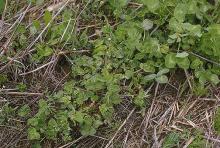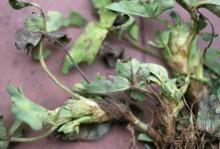Cause Ditylenchus dipsaci. The nematode lives mainly in red clover stems and buds; it attacks all red clover varieties now in use.
Symptoms Diseased plants are severely stunted, and stems show numerous swellings. Severely affected plants may die after a few seasons, leaving sparse areas in the field, which weeds may invade. The disease is most evident in early spring and affects only red clover varieties. Later, plants may be stunted and overgrown by adjacent plants or weeds and may be missed, allowing the infection to spread.
Sampling Stem nematodes infect aboveground portions of plants but also may be found in soil. Samples should include stems and buds of affected plants. Take samples any time during the growing season, but late spring is an ideal time to look for first signs of affected plants.
Cultural control
- Rotation with non-leguminous crops for 2 to 4 years, depending on the severity of infection.
Reference Jensen, H.J. 1961. Nematodes Affecting Oregon Agriculture. Oregon State University Experiment Station Bulletin 579.


